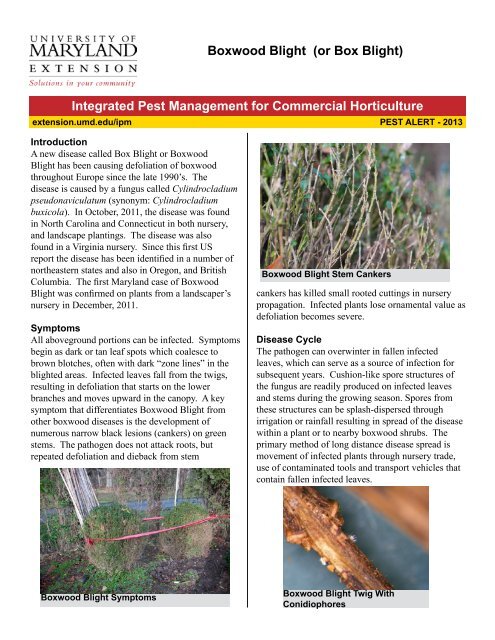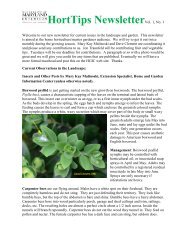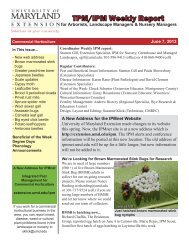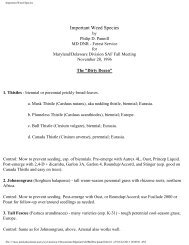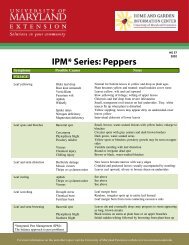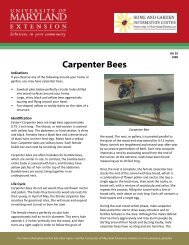Boxwood Blight - University of Maryland Extension
Boxwood Blight - University of Maryland Extension
Boxwood Blight - University of Maryland Extension
Create successful ePaper yourself
Turn your PDF publications into a flip-book with our unique Google optimized e-Paper software.
<strong>Boxwood</strong> <strong>Blight</strong> (or Box <strong>Blight</strong>)<br />
Integrated Pest Management for Commercial Horticulture<br />
extension.umd.edu/ipm PEST ALERT - 2013<br />
Introduction<br />
A new disease called Box <strong>Blight</strong> or <strong>Boxwood</strong><br />
<strong>Blight</strong> has been causing defoliation <strong>of</strong> boxwood<br />
throughout Europe since the late 1990’s. The<br />
disease is caused by a fungus called Cylindrocladium<br />
pseudonaviculatum (synonym: Cylindrocladium<br />
buxicola). In October, 2011, the disease was found<br />
in North Carolina and Connecticut in both nursery,<br />
and landscape plantings. The disease was also<br />
found in a Virginia nursery. Since this first US<br />
report the disease has been identified in a number <strong>of</strong><br />
northeastern states and also in Oregon, and British<br />
Columbia. The first <strong>Maryland</strong> case <strong>of</strong> <strong>Boxwood</strong><br />
<strong>Blight</strong> was confirmed on plants from a landscaper’s<br />
nursery in December, 2011.<br />
Symptoms<br />
All aboveground portions can be infected. Symptoms<br />
begin as dark or tan leaf spots which coalesce to<br />
brown blotches, <strong>of</strong>ten with dark “zone lines” in the<br />
blighted areas. Infected leaves fall from the twigs,<br />
resulting in defoliation that starts on the lower<br />
branches and moves upward in the canopy. A key<br />
symptom that differentiates <strong>Boxwood</strong> <strong>Blight</strong> from<br />
other boxwood diseases is the development <strong>of</strong><br />
numerous narrow black lesions (cankers) on green<br />
stems. The pathogen does not attack roots, but<br />
repeated defoliation and dieback from stem<br />
<strong>Boxwood</strong> <strong>Blight</strong> Symptoms<br />
<strong>Boxwood</strong> <strong>Blight</strong> Stem Cankers<br />
cankers has killed small rooted cuttings in nursery<br />
propagation. Infected plants lose ornamental value as<br />
defoliation becomes severe.<br />
Disease Cycle<br />
The pathogen can overwinter in fallen infected<br />
leaves, which can serve as a source <strong>of</strong> infection for<br />
subsequent years. Cushion-like spore structures <strong>of</strong><br />
the fungus are readily produced on infected leaves<br />
and stems during the growing season. Spores from<br />
these structures can be splash-dispersed through<br />
irrigation or rainfall resulting in spread <strong>of</strong> the disease<br />
within a plant or to nearby boxwood shrubs. The<br />
primary method <strong>of</strong> long distance disease spread is<br />
movement <strong>of</strong> infected plants through nursery trade,<br />
use <strong>of</strong> contaminated tools and transport vehicles that<br />
contain fallen infected leaves.<br />
<strong>Boxwood</strong> <strong>Blight</strong> Twig With<br />
Conidiophores
Hosts<br />
American, English and Korean boxwood are all<br />
susceptible to this new disease although some<br />
variation in disease severity among cultivars has been<br />
reported. Sweet box, Sarcococca, an ornamental<br />
that is in the boxwood family (Buxaceae) has been<br />
infected under experimental conditions. In 2012,<br />
the disease was confirmed causing leaf spots with<br />
yellow margins on Japanese pachysandra in a<br />
Connecticut landscape. According to Connecticut<br />
Agriculture Experiment Station plant pathologists,<br />
the pachysandra infections appear to have originated<br />
from adjacent infected boxwood plants. The disease<br />
has not been reported on pachysandra in nurseries or<br />
garden centers.<br />
Management<br />
Sanitation is critical for management <strong>of</strong> <strong>Boxwood</strong><br />
<strong>Blight</strong>. Diseased plants should be removed, bagged<br />
and disposed in municipal waste or buried under at<br />
least 2 feet <strong>of</strong> soil. Where permitted, infected plants<br />
may be burned. Plant debris should be collected by<br />
vacuuming, sweeping or raking, and then bagged and<br />
disposed in municipal waste. Infected plants or plant<br />
debris should not be composted.<br />
Research is under way to test the effectiveness <strong>of</strong><br />
fungicides for management <strong>of</strong> <strong>Boxwood</strong> <strong>Blight</strong> in the<br />
United States.<br />
An accurate diagnosis is very important in managing<br />
this disease. If you suspect you see boxwood infected<br />
with <strong>Boxwood</strong> <strong>Blight</strong>, please send samples <strong>of</strong><br />
twigs and foliage (wrapped in dry paper towels and<br />
<strong>Boxwood</strong> <strong>Blight</strong><br />
enclosed in double Ziploc bags) to the <strong>University</strong><br />
<strong>of</strong> <strong>Maryland</strong> Plant Diagnostic Laboratory for<br />
diagnosis. Submission information can be found at<br />
the <strong>University</strong> <strong>of</strong> <strong>Maryland</strong> Diagnostic Laboratory<br />
website at www.plantclinic.umd.edu.<br />
by<br />
Karen K. Rane, Director <strong>of</strong> the UMD Plant Diagnostic Clinic,<br />
<strong>University</strong> <strong>of</strong> <strong>Maryland</strong> <strong>Extension</strong>, College Park, MD, rane@umd.edu<br />
David L. Clement, <strong>Extension</strong> Specialist in Plant Pathology,<br />
<strong>University</strong> <strong>of</strong> <strong>Maryland</strong> <strong>Extension</strong>, clement@umd.edu<br />
The information given herein is supplied with the understanding that no discrimination is intended<br />
and no endorsement by <strong>University</strong> <strong>of</strong> <strong>Maryland</strong> <strong>Extension</strong> is implied.<br />
Read labels carefully before applying any pesticides.<br />
<strong>University</strong> <strong>of</strong> <strong>Maryland</strong> <strong>Extension</strong> programs are open to all citizens without regard to race, color, gender,<br />
disability, religion, age, sexual orientation, marital or parental status, or national origin.<br />
January 2013


